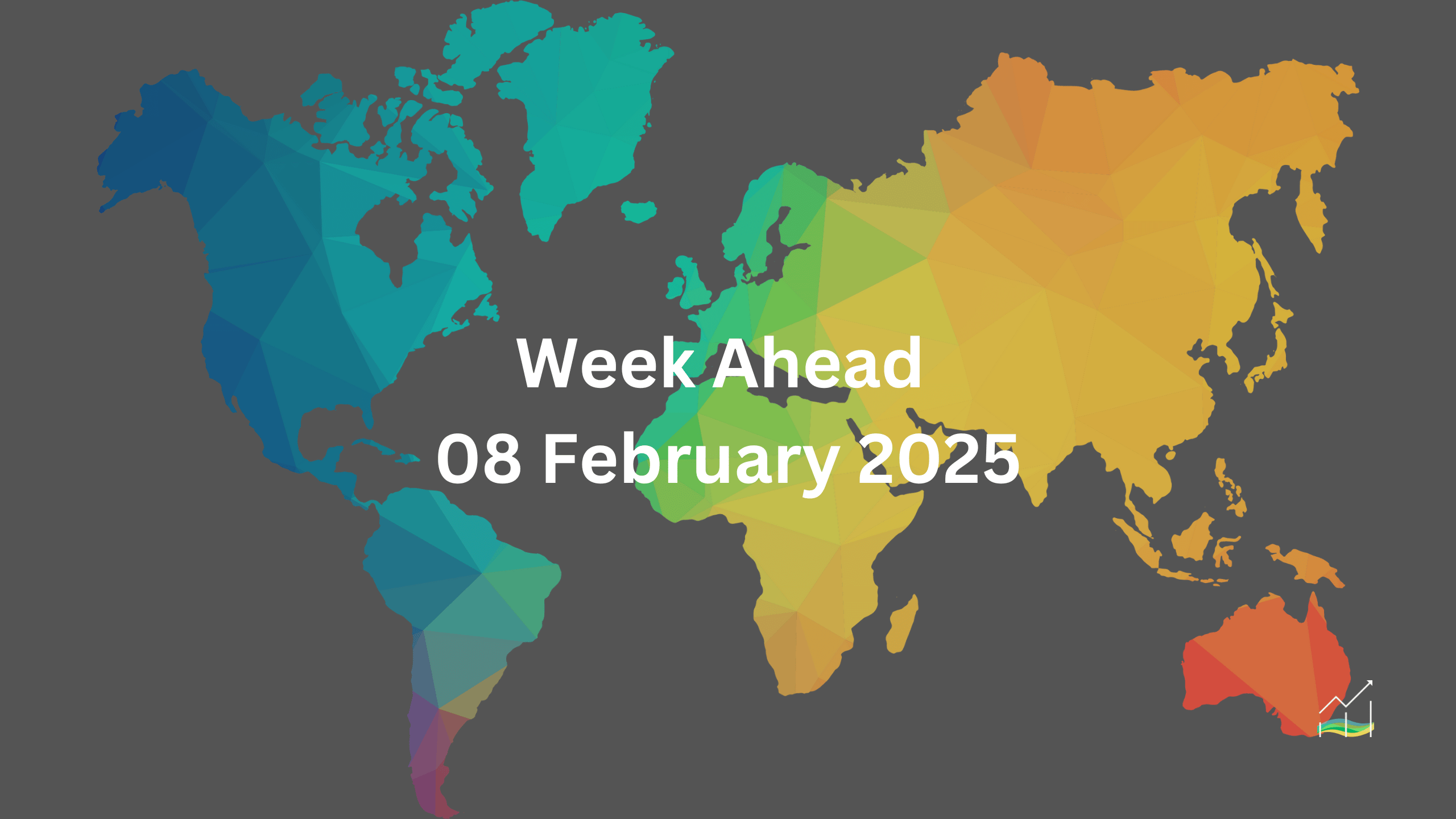08/02/2025 Week Ahead

U.S. Inflation & Fed Signals
Upcoming U.S. inflation data and comments from Federal Reserve Chair Jerome Powell will be crucial in shaping expectations for interest rates. Market participants will also be watching economic data from China, Japan, and the U.K., particularly U.K. GDP figures.
The market appears to have overlooked the volatility seen during Trump’s first term, but recent tariff threats on Canada and Mexico serve as a reminder. While key economic officials have dismissed concerns about political pressure on the Federal Reserve or the intent behind tariff threats, policy direction seems to remain under the control of the Oval Office rather than senior officials.
Despite some signs of a slowing labor market, rising average hourly earnings and a lower unemployment rate raise questions about how restrictive current U.S. monetary policy truly is. A strong January CPI report on February 12 could reinforce expectations of tighter conditions. Currently, markets do not fully price in a rate cut until September.
Last week, the U.S. 10-year yield hit a low of 4.40%—its lowest since mid-December—before rebounding after a strong jobs report and a surge in inflation expectations from the University of Michigan survey. Higher yields should support the U.S. dollar, particularly against the yen, which recently hit a two-month high. Unless disruptive headlines emerge, the greenback is likely to remain supported by the relative strength of the U.S. economy.
United States of America
Overview
The U.S. dollar remains supported by economic outperformance and wider rate differentials. While tariffs are typically seen as inflationary and could keep Federal Reserve policy restrictive for longer, they also act as a drag on consumption and investment. The Fed has signaled patience, making it unlikely to cut rates in the near term. Market expectations now lean toward a potential cut in Q3, though June or July remains a possibility.
Trade tensions continue to be a key focus, with recent tariff threats on Canada and Mexico postponed for now, while tariffs on China remain in place. The next target could be the European Union and other countries. These developments could have implications for monetary policy if they lead to sustained inflationary pressures.
Economic Drivers
Following the January jobs report and benchmark revisions, market attention now shifts to inflation. A 0.3% rise in both headline and core CPI is expected, keeping year-over-year rates steady at 2.9% and 3.2%, respectively. Meanwhile, producer price inflation may slow slightly, with the headline rate possibly ticking down to 3.1% from 3.3% and the core measure easing to 3.3% from 3.5%.
Despite a strong labor market, the Fed is expected to hold rates steady at its next meeting on March 19. The futures market currently assigns a one-in-three probability of a rate cut at the May 7 meeting, but the likelihood of easing has been pushed further into the second half of the year. Powell’s testimony to Congress this week will be closely monitored for policy signals.
Data and Events
Key U.S. economic data this week includes CPI on Wednesday, which will be a crucial indicator for the Fed’s next steps. Higher-than-expected inflation could reinforce expectations that rates will stay elevated for longer. Retail sales and industrial production data for January, due later in the week, will provide insight into the strength of consumer spending and business activity.
Additionally, producer prices and weekly jobless claims data will offer further clues about inflationary pressures and labor market conditions. The Treasury will conduct major bond auctions, selling $58 billion in three-year notes on Tuesday, $42 billion in 10-year notes on Wednesday, and $25 billion in 30-year bonds on Thursday.
Price Action
The Dollar Index (DXY) has found support in the 107.30–50 range. The prospect of reciprocal tariffs helped push it to 108.30, a move that was not achieved even after a stronger labor market report and a rise in consumer inflation expectations. The index formed a bullish outside-up day before the weekend, and a break above 108.60 could set the stage for a move toward 109.00–30.
U.S. yields rebounded from recent lows, with the 10-year yield recovering from 4.40% after the jobs report and a surge in University of Michigan’s inflation expectations (4.3% vs. 3.3%). Higher yields should support the dollar, particularly against the yen.
Key Points:
- U.S. inflation and Powell’s testimony will be key for rate expectations.
- CPI is expected to show steady inflation, while PPI may slow slightly.
- Market pricing suggests the first Fed rate cut is now likely in Q3.
- Tariff risks remain, with potential new targets beyond China, Canada, and Mexico.
- Retail sales, industrial production, and Treasury auctions will provide further market direction.
- The Dollar Index has strengthened, with resistance near 108.60 and potential upside to 109.30.
Australia
Overview
Australia's trade relationship with the U.S. remains stable, with a small trade deficit potentially shielding it from tariff risks under the new U.S. administration. However, the Australian economy faces growing challenges, with the Reserve Bank of Australia (RBA) expected to begin its rate-cutting cycle on February 18. Markets have already priced in nearly 100 basis points of cuts over the next year.
The upcoming national election, required to be held by May 17, has yet to become a major market focus but will draw more attention as it moves into the common three-month hedging window.
Economic Drivers
The RBA’s expected rate cuts reflect ongoing economic concerns, and recent data has done little to shift expectations. Consumer inflation expectations, tracked by the Melbourne Institute, have remained relatively stable, standing at 4.0% in January, down from December’s 4.2%. While this metric might attract some attention, it is unlikely to alter speculation that an easing cycle is imminent.
Data and Events
The economic calendar is relatively light in the coming days. Key releases include consumer and business confidence surveys early in the week, along with Q4 home loan value data. However, none of these are expected to significantly impact market direction.
Price Action
The Australian dollar briefly reached a nine-day high near $0.6300 ahead of the weekend but reversed lower following renewed tariff concerns. It briefly dipped below $0.6255, with a sustained break below $0.6250 potentially opening the door to losses in the $0.6170–$0.6200 range.
Key Points:
- The RBA is expected to start cutting rates on February 18, with 100 bps of easing priced in over the next year.
- Australia's upcoming election is not yet a market focus but will gain attention within the three-month window.
- Consumer and business confidence data, along with Q4 home loan values, are due but unlikely to move markets.
- The Australian dollar faces downside risk, with a break below $0.6250 potentially leading to further losses.
Canada
Overview
The ongoing tariff war with the U.S. poses a major risk to the Canadian economy. Even before the tariff tensions escalated, the divergence in monetary policy had already weighed on the Canadian dollar. Canada's two-year yield discount to the U.S. widened to nearly 167 basis points before the latest employment data, marking its largest gap in over 25 years. While it settled slightly below 160 basis points, the situation underscores the economic challenges ahead.
Adding to the uncertainty, Canada’s Parliament remains suspended until March 24 due to the Liberal Party’s leadership contest. This delay could restrict the government’s ability to introduce fiscal support at a time when Canada’s economy may take a significant hit. The Chamber of Commerce estimates that the tariff war could shave approximately 2.6% off Canada’s GDP.
Economic Drivers
Despite external risks, Canada’s labor market remains a source of strength. Recent data showed solid job growth in full-time positions and an unexpected drop in the unemployment rate. This has supported the Canadian dollar, particularly as the immediate tariff threat from the U.S. has been postponed.
Data and Events
This week’s Canadian economic calendar is relatively light, with only second-tier data releases such as December building permits, manufacturing sales, and wholesale trade figures. These are unlikely to significantly impact market sentiment.
Price Action
The Canadian dollar continues to hold its ground, benefiting from strong labor market data. The U.S. dollar found support last week around CAD 1.4260–1.4270, but momentum indicators suggest further downside potential. A decisive break below CAD 1.4200 could open the door for additional losses. Meanwhile, the odds of a Bank of Canada rate cut at its next meeting have fallen to 60%, down from 75% a week ago.
Key Points:
- The U.S.-Canada tariff dispute remains a key risk, with potential GDP losses of 2.6%.
- Canada's two-year yield discount to the U.S. reached its widest level in over 25 years.
- Parliament remains suspended until March 24, limiting fiscal policy options.
- Labor market strength and a delay in U.S. tariffs have supported the Canadian dollar.
- The U.S. dollar may face further downside, with key support at CAD 1.4200.
- Rate cut expectations for the Bank of Canada have eased, with a 60% probability of a cut next month.
China
Overview
China’s first set of inflation data for 2025 is the key focus in an otherwise quiet period for economic releases. Markets are looking for signs of improving consumer demand and firmer factory-gate prices as data is set to be released over the weekend. While Lunar New Year distortions will be present, any evidence of stronger demand will be viewed positively.
Beyond inflation, attention is also on trade-related developments, particularly as the tariff conflict with the U.S. unfolds. Both sides have taken measured steps, with the U.S. imposing a 10% tariff and China responding selectively. This has fueled cautious optimism about the possibility of negotiations, though analysts warn against expecting quick resolutions.
Economic Drivers
The U.S. administration appears to be in a continuous deal-making mode, treating economic relations as negotiable. However, with no clear tariff implementation strategy, uncertainty remains elevated. China, for its part, continues to manage the yuan’s exchange rate carefully, aiming for stability rather than strength or weakness. In a strong U.S. dollar environment, Beijing has been working to slow the yuan’s decline.
Interestingly, the yuan’s correlation with the euro (~0.70) has strengthened, while its correlation with the yen (~0.15) has weakened. This shift highlights changing market dynamics, particularly in the carry trade.
Data and Events
China’s inflation data is expected to show a pickup in consumer prices, with January’s CPI forecast to rise 0.4% year-over-year, up from December’s 0.1% increase. Factory-gate prices are also expected to show an improvement, with the decline in the producer price index narrowing to 2.2% from the previous 2.3% drop.
Additionally, China is set to release lending and money supply figures for January, as well as reports on direct investment flows, foreign exchange settlements, and the Q4 2024 current account balance. However, these figures are unlikely to have a significant impact on the exchange rate or equity markets.
Price Action
The offshore yuan (CNH) weakened slightly ahead of the weekend, with the U.S. dollar closing above CNH 7.31. Following the recent tariff announcement, the dollar briefly reached CNH 7.3735 last week. Since the Lunar New Year break, the People’s Bank of China (PBOC) has kept the dollar’s reference rate in a tight range, maintaining stability.
In the near term, there is potential for the USD/CNH pair to revisit the CNH 7.32–CNH 7.33 range. Over a slightly longer horizon, a return to CNH 7.3700 remains likely, given market conditions.
Key Points:
- China’s CPI is expected to rise 0.4% YoY in January, up from 0.1% in December.
- Factory-gate prices are likely to show a smaller decline of 2.2%, improving from December’s 2.3% drop.
- Trade tensions with the U.S. continue, but measured responses from both sides leave room for negotiation.
- The yuan’s correlation with the euro has strengthened (~0.70), while its correlation with the yen has weakened (~0.15).
- The PBOC has maintained a stable exchange rate post-Lunar New Year, with near-term potential for USD/CNH to trade between 7.32 and 7.33, and a longer-term move toward 7.3700.
Europe
Overview
The eurozone faces another quiet week, with economic data likely to reinforce expectations of further rate cuts. Industrial production and GDP figures for Q4 are set for release, along with final German inflation data. Political uncertainty looms as Germany heads to the polls on February 23, with the CDU expected to lead but questions remaining over potential coalition partners.
At the same time, the euro remains under pressure due to the relative strength of the U.S. economy and widening rate differentials. The U.S. tariff threat adds to the downside risks, while the swaps market continues to price in additional European Central Bank (ECB) rate cuts in the months ahead.
Economic Drivers
The eurozone economy remains fragile, with weak industrial production and GDP figures pointing to a sluggish recovery. The underperformance relative to the U.S., alongside a widening two-year yield spread, continues to weigh on the euro.
Germany’s upcoming election adds another layer of uncertainty. While the CDU is expected to lead the next government, the potential role of the far-right AfD remains unclear. Economic challenges and shifting geopolitical dynamics may push Germany to relax its strict fiscal rules, potentially paving the way for joint EU defense spending.
Data and Events
Key data releases this week include:
- French unemployment (Tuesday)
- Eurozone industrial production (Thursday)
- Final German inflation (Thursday)
- Q4 GDP data (Friday)
Bond auctions are also scheduled across Europe, with Germany selling €5 billion in five-year Bobls on Tuesday and a combined €2.5 billion in long-term Bunds on Wednesday. Additional auctions will take place in the Netherlands, Portugal, Greece, and Italy throughout the week.
Markets continue to expect another ECB rate cut at the March 6 meeting, with two quarter-point cuts fully priced in by mid-year and a 60% probability of a third.
Price Action
The euro’s recent rebound from tariff concerns faded near $1.0440. It has since tested the $1.03 level, and further downside pressure could push it toward $1.0255. The greenback remains supported by the recovery in the U.S. two-year yield premium over Germany.
Key Points:
- Eurozone industrial production and Q4 GDP data are expected to confirm economic weakness.
- Germany’s February 23 election adds political uncertainty, with potential fiscal policy shifts ahead.
- The U.S. economy’s outperformance and widening rate differentials weigh on the euro.
- The ECB is expected to cut rates further, with two cuts fully priced in by mid-year.
- The euro’s recent bounce failed at $1.0440, with further downside risk toward $1.0255.
Japan
Overview
With the Bank of Japan (BOJ) having raised rates in late January, further hikes are unlikely in the near term. The swaps market only sees a 50% chance of another move by July, with full pricing not expected until October. This puts the focus on external factors, particularly US Treasury yields, as key drivers of the yen’s performance.
Economic Drivers
The correlation between USD/JPY and the US 10-year Treasury yield remains strong, hovering around 0.70. While this is slightly below last year’s peak levels, the yen’s movements continue to be closely tied to shifts in US yields.
Japan’s current account balance typically worsens in December, a trend seen for 12 straight years. However, the trade balance often improves in the final month of a quarter, as seen in November’s nearly JPY100 billion surplus. A weaker yen and rising interest rates may help boost the yen value of foreign income, offering some support to Japan’s external position.
Data and Events
Japan will release:
- December current account data (historically weaker in December)
- January bank lending figures
Despite an overall trade deficit for most of 2024, Japan posted a surplus in November, aligning with a seasonal trend where Q4 trade balances tend to be the strongest of the quarter.
Price Action
The US 10-year yield fell to around 4.4% last week, its lowest level since mid-December, pushing the dollar lower against the yen. However, following the US employment report, the yield rebounded, and USD/JPY climbed back to JPY152.40 from a session low near JPY151.
A near-term bottom appears to be in place, with a move above JPY152.80 likely to confirm further dollar strength.
Key Points:
- BOJ is unlikely to raise rates again before mid-year, keeping focus on external drivers.
- USD/JPY remains highly correlated with the US 10-year Treasury yield.
- Japan’s current account balance typically weakens in December, but the trade balance often improves.
- The US 10-year yield’s rebound suggests a near-term bottom in USD/JPY.
- A move above JPY152.80 could confirm further dollar gains.
Switzerland
Swiss inflation data for January will be released on Thursday. If the figures support a subdued inflation outlook, it could strengthen expectations for another Swiss National Bank rate cut in March. Meanwhile, Switzerland is set to hold a bond auction on Wednesday.
United Kingdom
Overview
After a recent rate cut by the Bank of England, expectations are that they will pause at their next meeting in March before potentially cutting rates again in May. The UK has maintained a premium over the US on two-year bonds since late August, except for a brief period in late November. The correlation between changes in the British pound and the euro has also been notably strong, reflecting current market dynamics.
Economic Drivers
The UK economy has been struggling with stagnation. GDP data for Q3 showed contraction in October, followed by slight growth in November, with December expected to show a modest expansion. A key driver in Q4 has been government spending, alongside some strength in consumption. The Bank of England forecasts 1.5% growth for this year, with other organizations like the IMF and OECD predicting slightly higher growth rates. Despite the UK’s economic difficulties, inflation concerns remain a significant issue.
Data and Events
This week, attention will be on the release of UK GDP data for Q4 and December, particularly given the recent focus on the country’s weak economic performance. The outcome of this data will influence expectations regarding potential future interest rate cuts by the Bank of England. There are also market discussions around possible stagflation due to the weak economic performance alongside inflation concerns. The UK plans to launch new bond issuances, including a March 2035 gilt and a March 2045 index-linked gilt.
Price Action
Sterling traded within a range of $1.2250 to $1.2550 last week, settling near $1.2400. The momentum indicators remain constructive, but the market is approaching overbought territory. A combination of firm US inflation data and soft UK GDP figures could exert pressure on the pound. A break below the $1.2360-$1.2370 range could indicate a potential retest of recent lows.
Key Points:
- Bank of England likely to pause rate cuts in March, with further cuts expected in May.
- UK economy stagnating with weak Q3 data, but government spending provided a boost in Q4.
- The GDP data for December and Q4 will be crucial for assessing the UK’s economic outlook.
- Sterling remains under pressure, with a potential retest of recent lows if economic data disappoints.
- The Bank of England’s 1.5% growth forecast contrasts with higher predictions from the IMF and OECD.
- UK plans to launch new bonds in February, including a 2035 gilt and 2045 index-linked gilt.
© 2025 SKONE Enterprise (003319453-V). All rights reserved.
The content on this site is for informational purposes only and does not constitute financial advice.


